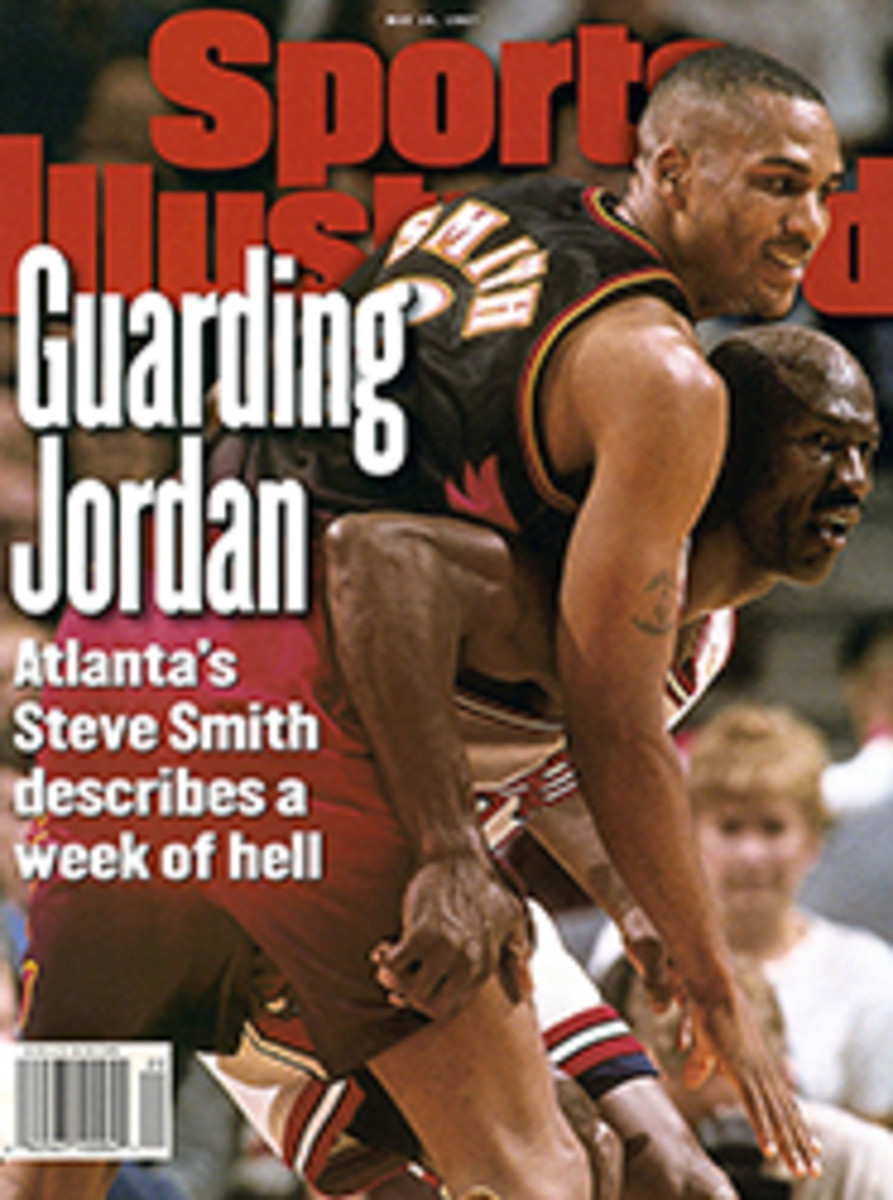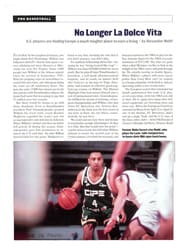
BOSTON IS ABUZZ OVER ITS ROOKIE SHORTSTOP WHO'S TOUGHEST, AND WHO'S EASIEST TO STEAL ON? AN EXPOS EXPLOSION
NOMAR, NO LESS
Rangers fans Mike and Denise McBride and their two-year-old son,
Tanner, were sitting in the front row behind third base at the
Ballpark in Arlington on May 2 when a foul ball came flying in
their direction. Red Sox rookie shortstop Nomar Garciaparra and
third baseman Tim Naehring were both in hot pursuit when
Garciaparra yelled to Naehring, "Hey, watch out for the baby!"
As he caught the ball, Naehring carefully avoided hitting the
kid. Mike McBride sent an E-mail to Boston's offices last week
praising Garciaparra for his considerateness. Add to that
Garciaparra's .302 batting average at the end of last week--with
16 extra-base hits, including two game-winning home runs--and
there's a new baseball hero in Beantown.
Garciaparra's only drawback may be his unwieldy surname, which
has teammates and fans alike referring to him by his unique
first name, the brainchild of his father, Ramon, who decided
that his son would not carry his name, merely the letters in it.
So just before the boy was born, Ramon experimented by jotting
those letters on a napkin. Armon? Romna? Onram? Manro? And
finally, Nomar! Ramon's wife, Sylvia, insisted that their son be
named Anthony. Alas, Anthony Nomar Garciaparra chose to go by
Nomar, because, as he says, "when somebody yells out 'Nomar,'
you don't have to worry about five people answering."
The 23-year-old Garciaparra, who grew up in Whittier, Calif.,
and starred at Georgia Tech, was the 12th pick in the 1994
draft. He hit .343 with 16 homers at Triple A Pawtucket last
season, and he has been the Red Sox' most consistent hitter so
far in '97. He could be the first Boston player since Fred Lynn,
in '75, to win the Rookie of the Year award.
Garciaparra's strong start is all the more remarkable because of
the pressure put on him when Boston's veteran shortstop, John
Valentin, left spring training for two days to protest being
shifted to second base. "Some people felt Nomar began the season
playing under a microscope," Red Sox manager Jimy Williams says.
"But the first time I saw him, I knew he had the instincts to be
a star."
Though he has hit well so far, Garciaparra is renowned more for
his glovework. His range is among the best in baseball, and at
week's end he owned the second-best fielding percentage (.988)
among American League shortstops. Says Red Sox first baseman Mo
Vaughn, "I nicknamed him Spiderman, because he's so quick, and
sometimes it seems like he can suspend in midair."
CATCH AS CATCH CAN
Crime is rampant at ballparks this season. Through Sunday,
stolen bases had increased by 12% over last year, to their
highest level in a decade. This places an even greater burden on
catchers, baseball's police officers. In these troubled times
for backstops, SI conducted a survey of all 28 major league
teams to identify the catcher most respected by base stealers.
The Rangers' Ivan Rodriguez was voted the top cop by a
landslide. "Rodriguez has got the mentality that if you get on
base, you've come into his house and he's going to either pick
you off or throw you out," says Twins DH Paul Molitor, who has
485 career steals. "He has tremendous confidence in his ability,
and with his footwork, velocity and accuracy, you're not going
to steal off him."
The numbers confirm Rodriguez's supremacy; he has led the major
leagues in percentage of runners thrown out stealing in three of
the last six years, though by a narrow margin he's not among the
leaders so far this season (chart, page 96). The other dangerous
arms mentioned most often belong to the Mariners' Dan Wilson,
the Marlins' Charles Johnson and the Astros' Brad Ausmus, who
has thrown out the Braves' Kenny Lofton three times this season.
Virtually all base stealers agree that on most attempts at
thievery the outcome depends more on the pitcher than the
catcher. "I always steal on the pitcher," says the Indians' Omar
Vizquel. "If you get a good jump, the catcher can have a bazooka
and it won't matter."
A good base stealer can go from first to second in 3.3 seconds,
and the average catcher needs approximately two seconds to get
the ball from his glove to second base, leaving the pitcher
about 1.3 seconds to deliver the ball. The pitcher is by far the
greatest variable in the equation. "Every first base coach has a
stopwatch and knows the pitcher's time," says Rockies catcher
Jeff Reed, who as of Sunday had gunned down nine of 14 runners
this year. "If the pitcher is 1.5 or 1.6 to the plate,
everybody's running, and the catcher's throw has got to be 1.8
and right on the bag. There aren't a whole lot of catchers who
can do that."
A pitcher's weapons in the battle are a good pickoff move, a
varied rhythm in his motion and a slide-step delivery, which
makes it hard for runners to take a big lead. According to our
survey, the toughest pitchers to steal on are Yankees ace Andy
Pettitte, who led all pitchers with 11 pickoffs last year; the
Mets' Armando Reynoso, a master at holding runners close; and
the Cubs' Terry Mulholland, whose delivery is so quick and
deceptive that over the last five seasons only 25 runners have
tried to steal against him. "I incorporated the slide step into
my delivery early in my career," says Mulholland. "There's
always a chance for a pickoff with it, and if you're quick to
the plate, a guy has to watch his lead from first."
To understand the pitcher's importance in controlling the
running game, check out the Dodgers, who made a concerted effort
during spring training to teach their starters--especially Hideo
Nomo, who allowed 52 steals last year--how to hold runners
close. After throwing out only 26 of 157 runners (17%) last
season, Los Angeles catcher Mike Piazza had thrown out 11 of 33
(33%) this year, through Sunday. Says Piazza, "Our pitchers
didn't even give me a chance last season. It was ridiculous. But
now they're giving me a shot. That makes a huge difference."
MONTREAL MADNESS
In the history of baseball no team has ever had a bigger sixth
inning. Montreal's 13-run outburst against San Francisco on May
7 equaled the record for most runs in that frame and was only
four runs shy of the biggest inning ever: the 17-run seventh
enjoyed by the Red Sox against the Tigers in 1953.
The Expos had already enjoyed a five-run fifth to take a 6-3
lead. Then the hit parade really began. The top of the sixth
included eight singles, three doubles, two home runs, no walks,
no errors, one balk, one hit batsman and three shaken Giants
pitchers. "Those guys hit every pitch, good or bad," said Giants
reliever Julian Tavarez, who allowed four runs while getting two
of the three outs in the inning. "It was like a bad dream. I
never saw anything like that in baseball, even in Little League."
The Expos set team single-inning records for most runs (13),
most hits (13), most consecutive hits (eight) and most batters
(17). Five Expos had two hits in the inning, including second
baseman Mike Lansing, who became the 31st player to hit two home
runs in one inning. "When I came back to the dugout after the
second one, I said, 'Damn, did I really just do that?'" Lansing
said. "None of us wanted to be the one to make the third out,
but, really, all you start thinking is, Jeez, when is this going
to quit?"
COLOR PHOTO: SCOTT JORDAN LEVY As expected, Garciaparra has fine range. Unexpectedly, he has a hot bat. [Nomar Garciaparra in game]
COLOR PHOTO: STEPHEN DUNN/ALLSPORT Our survey shows Rodriguez is the catcher whose arm is feared the most by the top base stealers. [Ivan Rodriguez in game]
THE ARMS RACE
A catcher's success rate in throwing out base stealers is not as
revealing as most baseball statistics, because the pitcher's
role in stolen-base attempts is so important. A pitcher must
hold runners close and deliver the ball quickly for the catcher
to have a chance to throw them out. Nevertheless, a look at
catchers' performances can tell a lot about which backstops have
been the hardest and easiest to steal against so far this
season. (Note: The toughest guy to run on year in and year out,
the Rangers' Ivan Rodriguez, didn't make the list because at
week's end he had thrown out seven of 17 runners [41.2%], just
missing the cut.)
Caught-
Player, Team Attempts* Pct.
THE BEST
BRAD AUSMUS, Astros 9-16 .563
CHARLES JOHNSON, Marlins 9-19 .474
JIM LEYRITZ, Angels 9-19 .474
DAN WILSON, Mariners 16-35 .457
RICK WILKINS, Giants 10-23 .435
THE WORST
RON KARKOVICE, White Sox 1-19 .053
CHRIS WIDGER, Expos 2-28 .071
CHRIS HOILES, Orioles 2-26 .077
BRIAN JOHNSON, Tigers 2-23 .087
DARRIN FLETCHER, Expos 3-27 .111
*Minimum 0.4 attempts per scheduled game Source: STATS, Inc.

